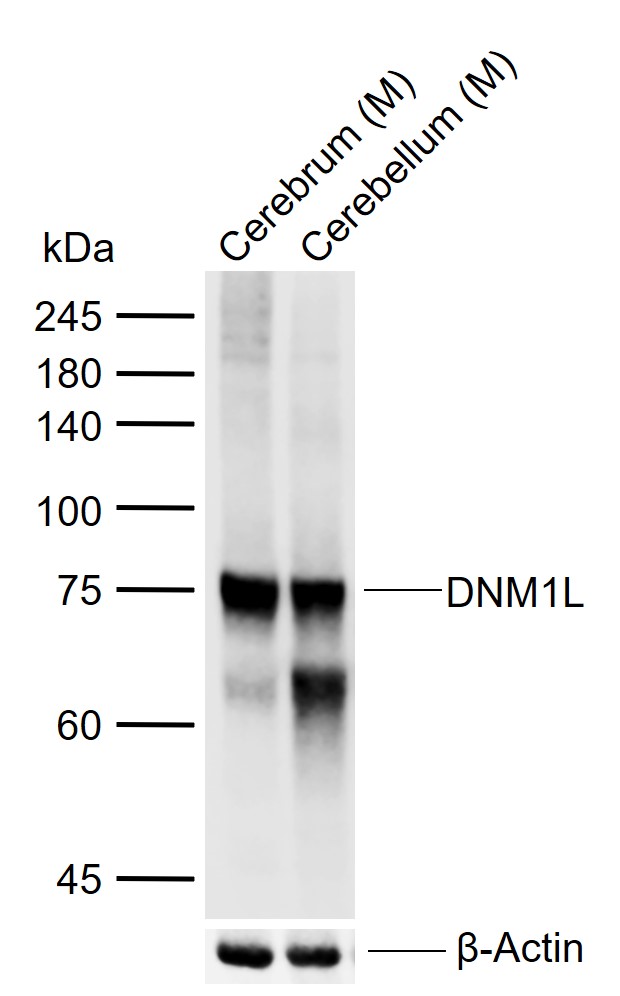
Rabbit Anti-DNM1L antibody
DLP1; DRP1; DNM1L_HUMAN; Dnm1p/Vps1p-like protein; DVLP; Dymple; Dynamin 1 like; Dynamin family member proline-rich carboxyl-terminal domain less; Dynamin like protein; Dynamin related protein 1; Dynamin-1-like protein; Dynamin-like protein 4; Dynamin-lik
View History [Clear]
Details
Product Name DNM1L Chinese Name 动力相关蛋白1抗体 Alias DLP1; DRP1; DNM1L_HUMAN; Dnm1p/Vps1p-like protein; DVLP; Dymple; Dynamin 1 like; Dynamin family member proline-rich carboxyl-terminal domain less; Dynamin like protein; Dynamin related protein 1; Dynamin-1-like protein; Dynamin-like protein 4; Dynamin-like protein; Dynamin-like protein IV; Dynamin-related protein 1; DYNIV 11; FLJ41912; HdynIV; VPS1. literatures Research Area Tumour immunology Neurobiology Signal transduction Apoptosis Transporter The new supersedes the old Mitochondrion Immunogen Species Rabbit Clonality Polyclonal React Species Human, Mouse, Rat, (predicted: Dog, Horse, ) Applications WB=1:500-2000 ELISA=1:5000-10000 IHC-P=1:100-500 IHC-F=1:100-500 IF=1:100-500 (Paraffin sections need antigen repair)
not yet tested in other applications.
optimal dilutions/concentrations should be determined by the end user.Theoretical molecular weight 81kDa Cellular localization cytoplasmic Mitochondrion Form Liquid Concentration 1mg/ml immunogen KLH conjugated synthetic peptide derived from human DNM1L: 101-200/763 Lsotype IgG Purification affinity purified by Protein A Buffer Solution 0.01M TBS(pH7.4) with 1% BSA, 0.03% Proclin300 and 50% Glycerol. Storage Shipped at 4℃. Store at -20 °C for one year. Avoid repeated freeze/thaw cycles. Attention This product as supplied is intended for research use only, not for use in human, therapeutic or diagnostic applications. PubMed PubMed Product Detail The protein encoded by this gene is a member of the dynamin superfamily of GTPases. Members of the dynamin-related subfamily, including the S. cerevisiae proteins Dnm1 and Vps1, contain the N-terminal tripartite GTPase domain but do not have the pleckstrin homology or proline-rich domains. This protein establishes mitochondrial morphology through a role in distributing mitochondrial tubules throughout the cytoplasm. The gene has 3 alternatively spliced transcripts encoding different isoforms. These transcripts are alternatively polyadenylated. [provided by RefSeq, Jul 2008].
Function:
Functions in mitochondrial and peroxisomal division. Mediates membrane fission through oligomerization into ring-like structures which wrap around the scission site to constict and sever the mitochondrial membrane through a GTP hydrolysis-dependent mechanism. Required for normal brain development. Facilitates developmentally-regulated apoptosis during neural tube development. Required for a normal rate of cytochrome c release and caspase activation during apoptosis. Also required for mitochondrial fission during mitosis. Required for programmed necrosis execution. May be involved in vesicle transport.
Isoform 1 and isoform 4 inhibit peroxisomal division when overexpressed.
Subunit:
Homotetramer; dimerizes through the N-terminal GTP-middle region of one molecule binding to the GED domain of another DNM1L molecule. Can self-assemble in multimeric ring-like structures. Interacts with BCL2L1; the interaction stimulates the GTPase activity of DMN1L in synapses and increases the number of axonal mitochondria and the size and number of synaptic vesicle clusters. Interacts with FIS1 (By similarity). Interacts with GSK3B and MARCH5. Interacts (via the GTPase and B domains) with UBE2I; the interaction promotes sumoylation of DNM1L, mainly in ite B domain. Interacts with PPP3CA; the interaction dephosphorylates DNM1L and regulates its transition to mitochondria. Interacts witn MID49 and MID51. Interacts with PGAM5; this interaction leads to dephosphorylation at Ser-637 and activation of GTPase activity and eventually to mitochondria fragmentation.
Subcellular Location:
Cytoplasm, cytosol. Golgi apparatus. Endomembrane system; Peripheral membrane protein. Mitochondrion outer membrane; Peripheral membrane protein. Note=Mainly cytosolic. Translocated to the mitochondrial membrane through O-GlcNAcylation and interaction with FIS1. Colocalized with MARCH5 at mitochondrial membrane. Localizes to mitochondria at sites of division. Localizes to mitochondria following necrosis induction. Associated with peroxisomal membranes, partly recruited there by PEX11B. May also be associated with endoplasmic reticulum tubules and cytoplasmic vesicles and found to be perinuclear. In some cell types, localizes to the Golgi complex.
Tissue Specificity:
Ubiquitously expressed with highest levels found in skeletal muscles, heart, kidney and brain. Isoform 1 is brain-specific. Isoform 2 and isoform 3 are predominantly expressed in testis and skeletal muscles respectively. Isoform 4 is weakly expressed in brain, heart and kidney. Isoform 5 is dominantly expressed in liver, heart and kidney. Isoform 6 is expressed in neurons.
Post-translational modifications:
Phosphorylation/dephosphorylation events on two sites near the GED domain regulate mitochondrial fission. Phosphorylation on Ser-637 inhibits mitochondrial fission probably through preventing intramolecular interaction. Dephosphorylated on this site by PPP3CA which promotes mitochondrial fission. Phosphorylation on Ser-616 also promotes mitochondrial fission.
Sumoylated on various lysine residues within the B domain, probably by MUL1. Sumoylation positively regulates mitochondrial fission. Desumoylated by SENP5 during G2/M transition of mitosis. Appears to be linked to its catalytic activity.
S-nitrosylation increases DNM1L dimerization, mitochondrial fission and causes neuronal damage.
Ubiquitination by MARCH5 affects mitochondrial morphology.
O-GlcNAcylation augments the level of the GTP-bound active form of DRP1 and induces translocation from the cytoplasm to mitochondria in cardiomyocytes. It also decreases phosphorylation at Ser-637.
DISEASE:
Note=May be associated with Alzheimer disease through beta-amyloid-induced increased S-nitrosylation of DNM1L, which triggers, directly or indirectly, excessive mitochondrial fission, synaptic loss and neuronal damage.
Defects in DNM1L are the cause of encephalopathy, lethal, due to defective mitochondrial and peroxisomal fission (EMPF) [MIM:614388]. EMPF is a rare autosomal dominant systemic disorder resulting in lack of neurologic development and death in infancy. After birth, infants present in the first week of life with poor feeding and neurologic impairment, including hypotonia, little spontaneous movement, no tendon reflexes, no response to light stimulation, and poor visual fixation. Other features include mildly elevated plasma concentration of very-long-chain fatty acids, lactic acidosis, microcephaly, deep-set eyes, optic atrophy and hypoplasia, and an abnormal gyral pattern in both frontal lobes associated with dysmyelination.
Similarity:
Belongs to the dynamin family.
Contains 1 GED domain.
SWISS:
O00429
Gene ID:
10059
Database links:Entrez Gene: 10059 Human
Omim: 603850 Human
SwissProt: O00429 Human
Unigene: 556296 Human
Unigene: 216851 Rat
Product Picture
References (0)
No References
Bought notes(bought amounts latest0)
No one bought this product
User Comment(Total0User Comment Num)
- No comment



 +86 571 56623320
+86 571 56623320
 +86 18668110335
+86 18668110335

